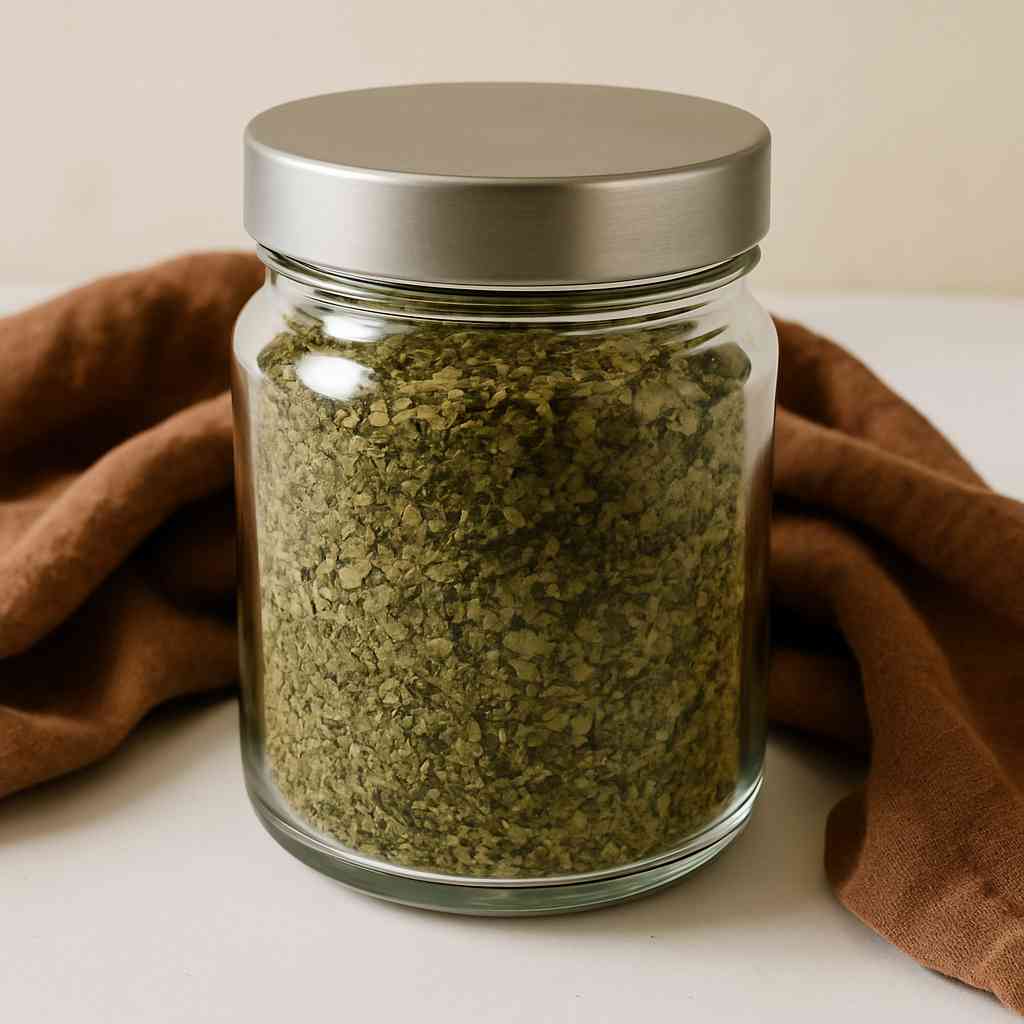Basil is prominent in its cooking and health benefits. The antioxidant and anti-inflammatory abilities of this versatile herb can block free radicals and reduce inflammation.
It is a warm season herb that thrives between spring and summer. In most regions, basil is planted after the final frost of spring and continues to grow violently throughout the summer, often until the first fall frost.
Basil plants cannot withstand cold and frost, so basil leaves must be preserved to enjoy aromatic flavors even after the growing season.
The leaves can be dried, frozen or converted to pesto to preserve the herb’s taste and aroma. This way, you can continue to add the essence of summer to your dishes, even during cold seasons when fresh basil is not available.
To dry fresh basil naturally, dry the harvested leaves after washing and tie the stems into small bundles.
It hangs upside down in a warm, dry, airy place from direct sunlight.
After 1-2 weeks, once the leaves are crisp, remove them in an airtight container away from the light and store them.
It may seem simple, but it is important to properly store the dried basil leaves obtained. I will share it by the end of this article.
How to harvest basil for drying?

To make your dried basil actually taste and smell amazing? Basil should be chosen the right way. Because that’s half the game.
When harvesting basil, the correct way to do it is not just hanging the leaves. It actually helps your plants grow into bushy and keeps their dry leaves very flavorful.
When will you harvest it?
The best time to harvest basil is before the plant begins to flower. This is when the oil and therefore the flavor is at its peak. Ideally:
Morning harvest, when the dew is dry, before the sun gets strong. Choose mature stems about 6-8 inches long and use lush green leaves.
If the basil has already started to bloom, pinch the flowers and redirect energy to the leaves. It’s still easy to use, but the leaves tend to be slightly bitter after flowing.
How to harvest?
Use clean, sharp garden shears or scissors. Cut it just above the leaf node (two leaves fill the stem). This promotes branching and growth. You can continue to produce it by avoiding harvesting more than a third of the plants at once.
How to prepare basil for drying?
Gently rinse the basil stems under cold water to remove any dirt and insects. Shake excess water and dry with a clean kitchen or paper towel. Spread the leaves and allow them to air dry completely. Moist leaves can be molded during the drying process, so make sure they are completely dry before you begin.
Check this: How to grow blanket flowers?
How to dry basil naturally?


Naturally drying basil is not only cost-effective, but also simple and environmentally friendly, making it perfect for those looking to preserve the real herbal scent.
By air-dried basil at its own pace, it gently retains the vibrant colours, distinctive aromas and concentrated flavors of the herbs using electricity and special equipment.
1. How to hang bundles
This method has a natural approach to drying basil, which depends on air circulation rather than heat.
Tie small bundles of basil stems together and suspend upside down in a ventilated, dry area, allowing the leaves to slowly lose moisture while preserving essential oils and rich aromas.
Groups 4–6 decorate the stems together and secure them with strings or rubber bands. Hang the bundle upside down in a shady, dry, warm, ventilated area (such as a pantry, attic, or unused room). You can place a paper bag with holes around the bundle to keep dust away and speed up drying. Hang it for 7-14 days depending on the humidity. Basil is ready when the leaves are crisp and easily crumbling.
2. How to dry trays or screens


Compared to bundle hanging methods, tray or screen drying techniques are faster and more uniform and dry, as each basil leaves are spread across a single layer for optimal airflow and exposure.
Remove the leaves from the stems and spread them over a single layer of clean, dry surfaces, such as a mesh screen, wire rack, baking tray, or paper towel. Store the tray in a dry, ventilated place from direct sunlight. Roll the leaves every day to prevent stinging and even promote dryness. The leaves will dry in about 5-10 days. Do not stack leaves to reduce the risk of mold.
Both of these methods take longer than using an appliance, but they are gentle and better preserve the essential oils.
For those aiming for the purest and most aromatic dry basil, the patience of the natural drying method rewards with excellent quality and flavor.
Other ways to dry basil


Natural drying methods preserve the essential oils and flavor of basil very well, but due to weather conditions, you may need to quickly dry the basil.
In that case, other drying methods, such as drying the oven or using a dehydrator, are great options.
1. Dry the basil with a dehydrator
The process is fast and excellent at processing large batches, but some home cooks may notice slight trade-offs in flavor strength compared to air-dried basil, but it remains an excellent way to store herbs for long-term use, especially if outdoor drying is not practical.
Place clean, dried basil leaves in a single layer of a dehydrator tray. Set the dehydrator to low temperature: 95F to 115F. Drying usually takes 4-6 hours depending on the size of the leaves and moisture content. The leaves are crisp and crumbling with a light touch.
2. Dry the basil in the oven
Drying basil in the oven is a popular and practical method. Especially if you want immediate results or live in a humid environment where dry air is a challenge.
Preheat the oven to the lowest possible setting. Ideally it’s under 200F. Spread the basil leaves in a single layer on a baking tray with the back of the parchment. Props open the oven door slightly to let moisture escape. Check the basil every 15-20 minutes. It usually takes 1.5-2 hours to dry. The leaves should be dry and brittle, but not brown.
Also Read: How to dry fresh lavender from your garden?
How to store dried basil?
Proper storage keeps dried basil strong and can be used for months.
To maintain the herb’s distinctive aroma and taste, always place dry basil in an airtight container to keep it away from heat, moisture and direct sunlight.
Label each jar with harvest date and use within a year for the best flavor.
Leave the whole thing later or crush it later
The entire leaves retain more oil and flavor than crushed ones. Mold the leaves just before use to release the scent.
Use airtight containers
Store basil in a glass jar, metal can, or in a sealed plastic container. Do not store in paper or loosely closed bags.
Dark, cool storage
Place the container in a dark, cool, and dry place. A pantry or cabinet is ideal. Keep away from direct sunlight, stoves, or other heat or moisture sources.
Labels and dates
Basil is the most flavorful when used within 6-12 months. Label the jars on a dry day so that you can track the freshness.
How to use dried basil?
Dried basil is very versatile and can be used in a variety of ways. Sprinkle pasta sauce, soup or stew with a herbaceous burst or mix it with a salad dressing, marinade, or seasoning blend.
Cooking use
Add to sauces, soups, stews, marinades, roasted vegetables, pizza and pasta. Dried herbs are more concentrated, so use about a third of the amount of fresh basil.
Seasoning Blend
Combine dried basil with oregano, thyme, garlic powder and chili flakes to create an Italian or Mediterranean spice mix. Perfect for meat rubbing, salad dressings and bread dips.
Basil tea
Soak 1 teaspoon of dried basil in hot water for 5-7 minutes. Optional: Add honey or lemon. Basil tea may help in digestion and relieve stress.
Herb Infused Oil or Butter
Mix the dried basil in olive oil and store in a sealed bottle for 1-2 weeks before using with dressing or drizzling. Mix with soft butter and garlic to give it a rich flavour.
Conclusion
Dried basil is a simple yet rewarding way to store one of the summer’s most beloved herbs.
By harvesting at the right time and choosing the right drying method, whether natural, using a dehydrator, or choosing the right drying method in the oven, you can retain the essence of basil for a long time after the end of the growth season.


Computer Science Alumnus Khaja Moinuddin is delighted with gardening and homestead. Join him on this blog as he shares his experiences in homesteading, gardening and composting





